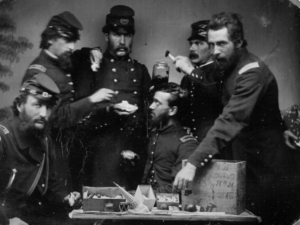![]() Tioronda in Beacon, NY, was the country estate of General Joseph Howland, widely regarded as Beacon’s premier philanthropist.
Tioronda in Beacon, NY, was the country estate of General Joseph Howland, widely regarded as Beacon’s premier philanthropist.
Joseph Howland was born in 1834 in New York City into a family that accumulated significant wealth in the China Trade. His ancestry includes a signer of the 1620 Mayflower Compact. His father, Samuel Shaw Howland, was a partner in the shipping firm Howland & Aspinwall, and his mother, Joanna Esther Hone, was the niece of Philip Hone, who served as mayor of New York City.
In 1859, Howland acquired 97 acres of farmland at the base of Mt. Beacon, which was then known as Matteawan. On this land, Howland constructed the family country estate along with the gothic-style Tioronda Mansion, designed by architect Frederick Clarke Withers, who had previously partnered with Calvert Vaux.
Ad
The structure was completed in 1861 and was originally named “Glenhurst.” The Howlands later changed the name to the Native American term for “meeting of the waters” or “Tioronda.” The house was filled with custom-made furniture, and it was steam-heated and lit by gas produced right on the property.
Howland dreamed of living the life of a country gentleman. However, this dream and lifestyle did not last long. At the outbreak of the Civil War in 1861, Howland enlisted with the 16th New York State Volunteers. After a brief period, he was promoted to colonel and, in that role, served at the first battle of Bull Run and, in 1862, at the Battle of Gaines’ Mill.
He was wounded in the leg at Gaines’ Mill. Despite his injury, he refused to leave his troops until the battle had been decided. This act earned him a citation for bravery and a promotion to Brigadier General. However, due to his wound, he could not serve in that position and retired from the military.
General Howland served as New York State Treasurer from 1866 to 1867. He actively drafted the trust deeds for Cornell University and organized the Hudson River State Hospital for the Insane.
![]() In Matteawan, Howland was instrumental in building the Presbyterian Church and the public library that still bears his name. The building is now the Howland Cultural Center and is listed on the National Register of Historic Places. The library moved to an expanded Main Street location in 1976. He also took an active part in establishing the National Bank at Fishkill-on-Hudson and Highland Hospital in Matteawan.
In Matteawan, Howland was instrumental in building the Presbyterian Church and the public library that still bears his name. The building is now the Howland Cultural Center and is listed on the National Register of Historic Places. The library moved to an expanded Main Street location in 1976. He also took an active part in establishing the National Bank at Fishkill-on-Hudson and Highland Hospital in Matteawan.
The General passed away in 1886, and in 1915, the property was converted into the nation’s first privately run psychiatric center. Tioronda was renamed Craig House and was managed by Dr. Clarence Slocum, who had very progressive concepts for that day. Most “asylums” back then resembled prisons more than treatment centers. Dr. Slocum however, believed in progressive treatments that included intensive talk therapy, freedom to take walks and participate in recreational activities, and fine dining. Craig House had golf, skiing, swimming, a gymnasium, and painting facilities.
In short order, Craig House gained a national reputation and became the treatment center of choice for a who’s who list of the rich and famous. Tioronda’s conversion from a country estate to a mental health facility would have pleased the General. Both General Joseph and his wife had a lifelong passion for the humane treatment of those suffering from mental health issues. In 1999 Craig House closed its doors. The structure has remained unused and decaying since then.
What’s happening with this impressive property? Other than the rapid decay, it’s hard to tell. Rob Yasinsac of Hudson Valley Ruins provides this information:
“A 2003 auction emptied the house of its fine furnishings and antiques. Investor and art collector John L. Stewart bought Tioronda that same year, and in this time the property has remained disused. Stewart’s company Tioronda, LLC, plans a “small residential development” on the estate. The mansion will be a single-family residence. In October 2011, two buildings, the carriage house and a workshop, were demolished.”
It would be a travesty if this fine structure decayed to the point of no return. Similar to the fate of many other Hudson Valley structures, it may however come to pass.
*The name Beacon was adopted when in 1913 the villages of Matteawan and Fishkill-On-Hudson were incorporated as the City of Beacon. While the name Fishkill-On-Hudson is hardly used, the name Matteawan is still used by many local residents when referring to the area surrounding the base of Mt. Beacon.
The Sojourner
Share this!
082224

